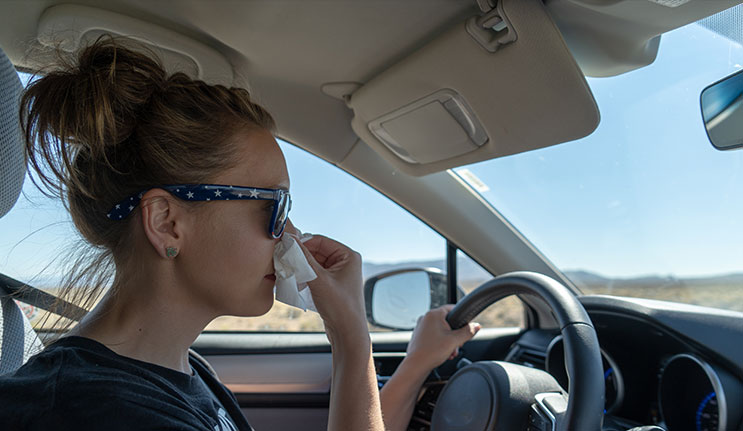26% of U.S. workers go to work when they are sick, according to MarketWatch. You might think that clocking in when you’re feeling under the weather will earn you brownie points at work and ensure that the job gets done. However, driving with certain illnesses can make you a significant risk on the road. So, how do you determine whether your illness is one that’s safe for you to be behind the wheel with?
Illnesses to Avoid Driving With
There are some illnesses which are a definite no-no to drive with. A severe cold or a bout of the flu is one illness for which you should always call in sick. Research from Lloyds TSB Insurance found that drivers with a cold scored 11% worse on a hazard simulator than drivers who were fit and healthy. Further research shows that your driving skills can decline by as much as 50% when driving with a cold as it can reduce reaction time and concentration levels. Other illnesses to avoid driving with include eye infections as these typically cause blurred vision, ear infections as they can lead to dizziness and disorientation, and other acute infections, such as urinary tract infection (UTI) and kidney infection.
Feeling sick
If you’ve picked up a stomach bug, it’s essential that you take a day or two off work and avoid driving at all costs. The symptoms of a stomach bug usually manifest within 24 to 72 hours of exposure and can hit you quickly. As this kind of bug can cause crippling stomach pain, muscle aches, and frequent trips to the bathroom, you shouldn’t get behind the wheel. If you are driving when your symptoms start, consider pulling off the road and arranging for someone to pick you up and take you home.
You may even experience sickness as a result of the motion from your own driving. Motion sickness is commonly experienced by passengers, however, drivers can be struck down with this condition, too. Thankfully, motion sickness is usually only a temporary condition, but you should never drive when this feeling materializes. Scott Clark Honda advises that drivers need to carefully consider their seating position, always sit up straight, and stare straight ahead rather than unnecessarily looking out of your side windows to limit the risk of motion sickness. Other precautions to take include taking motion sickness tablets, sticking to nutritious, non-fatty foods before and during driving, and keeping a bottle of water conveniently accessible. But if you do feel sick when you’re out on the road, always pull out of traffic, park in a safe spot, and take a break until your temporary illness passes. If it persists, make sure to call in sick for the rest of the day and make arrangements to return home as a passenger rather than a driver.
Am I sick enough?
Sickness doesn’t just come in the form of the sniffles or a headache. Painful, sore, and achy joints are all illnesses that can be dangerous to work with. The American Chiropractic Association (ACA) reports that 264 million work days are lost each year as a result of workers experiencing back pain. While it’s great that workers are calling in sick and resting when back pain strikes, it appears that most aren’t taking a long enough respite. Shape reports that 60% of U.S. workers take fewer than 5 days of sick leave per year, whereas, The Good Body advises that 90% of acute back pain cases take up to 6 weeks to resolve. Driving when you’ve got back pain is unwise as up to 60% of drivers state that driving worsens their back pain. It can also put you at risk for a road accident as your ability to react to situations may be hindered by the pain. Therefore, if you’re battling with a painful back, make sure it’s fully recovered before you return to driving.
Keep Your Fleet Drivers Safe on the Road with These eLearning Courses on Distracted Driving:
Review your medications
You might think that a quick visit to your doctor and a few tablets will mean you’re fighting fit for work, however, you should carefully review the side effects of any medication you’re taking before recommencing any driving work. Some cold and flu tablets can make you drowsy, as can many cough medicines, decongestants, and antihistamines, which are all commonly taken when a cold or the flu occurs. Opioids are regularly taken by many Americans, with 191 million prescriptions issued for them in 2017, according to the American Physical Therapy Association. But these painkillers, which are used to treat acute conditions, are renowned for causing drowsiness.
Medications for cognitive conditions that you think you’ve got under control can be problematic, too. 13% of Americans take antidepressants, according to Time, and numbers continue to rise. But, it’s important to check whether the ones you’ve been prescribed cause sleepiness as many brands cause drowsiness due to them having a sedation-type effect on the body. Medications for anxiety disorders, including stress, panic disorder, and phobias all have a similar impact on the body and can result in excessive tiredness. If you are on any of these medications, talk to your doctor and discuss an alternative solution so that you can drive safely.
We all fall ill from time to time, and while it can be tempting to ignore your symptoms, you could be doing more harm than good. As such, when you’re feeling far from your best, be sure to take the day off work and rest up. By doing so, your health and other road users will thank you for it.
About the Author

Amy Fletcher is a freelance writer and researcher with a keen interest in road safety. She has written for various online magazines, blogs, and journals in recent years. When she’s not writing, she enjoys long walks with her daughter and two dogs.
Keep your employees safe at work with these training courses on fleet safety:
Speeding Awareness – Large Vehicles



